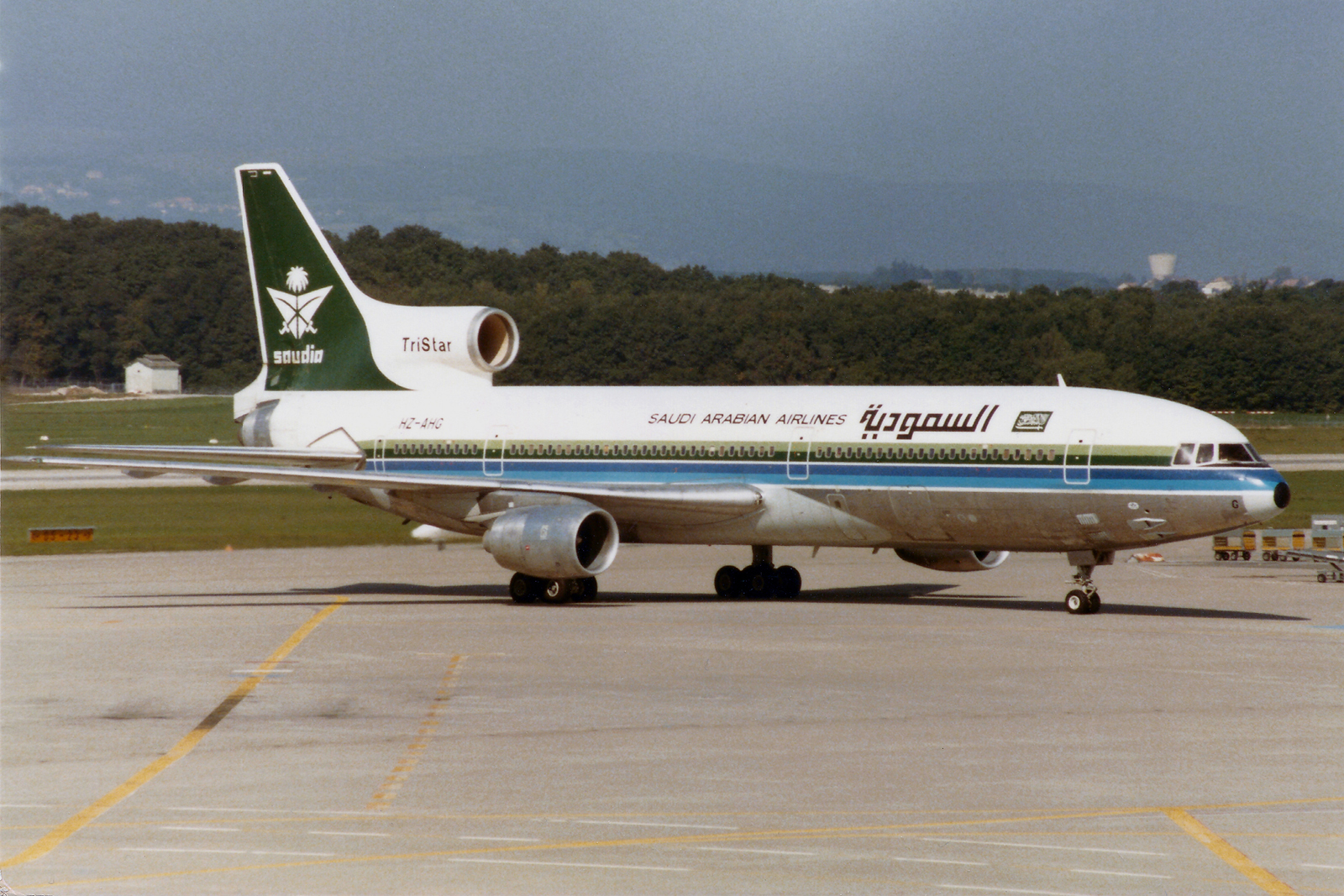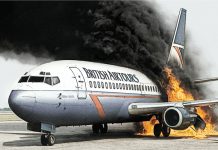- Saudia Flight 163
- 19 August 1980, Riyadh, Saudi Arabia
- Lockheed L-1011 Tristar
- In-flight fire followed by successful landing
- Passengers: 287
- Crew: 14
- Survivors: 0
If Chicken Little tells you that the sky is fallin’
Even if it wasn’t would you still come crawlin’
Aerosmith lyrics are an unlikely place to start an exposition on an aircraft accident although, even if the first part of the rock group’s name is ‘Aero’. Having got that writers caveat out of the way I can tell you Chicken Little and the overstated claim the sky is falling is a story at least 2500 years old that, believe it or not (irony intended), has relevance today. The Chicken Little moral, depending on the ending-variation and modern sensibilities, goes one of three ways:
- Where fox eats Chicken Little, the moral is don’t believe everything you hear.
- When Chicken Little makes it to the king the moral is have the courage to speak out no matter what.
- In modern popular culture the moral reduces to a name for someone who unnecessarily incites fear.
I think all three lessons are important in a modern safety culture. Especially when we consider what Aerosmith tells us in song:
We’re seein’ things in a different way…
The eyes of the general manager compared with the eyes of the pilot compared with the eyes of the engineer compared with the eyes of the passenger are often ‘seein’ risk in different way. And out of this ‘mis-seein’ emerges one of the biggest challenges in safety management: expressing safety threats with neither under or over-statement.
No one likes a ‘shrillster’: the one who (shrilly) overstates a threat and expects the immediate movement of financial heaven and financial earth to comprehensively address the perceived threat (sometimes to the detriment of other threats). At the same time we shouldn’t like the ‘under-stater’ — the one who, with a cool professional bedside manner, takes themselves and everyone else to the scene of the preventable accident with nary a tonal change along the troubled way. This makes me wonder what our greatest temptation might be as aviation professionals: over or understatement?
I used to think it might be overstatement but a fresh look at a haunting example makes me think it’s probably the opposite. This was the announcement to passengers on Saudi Flight 163, a Lockheed TriStar, on 19th August 1980:
‘Please, everybody sit down, move out of the way, everybody sit down, move out of the aisle, there is no danger from the airplane, everybody should stay in their seats.’
The smoke filling the cabin and the lungs of the 287 passengers said something different. Flight 163 was only 7 minutes into its flight from Riyadh to Jeddah, Saudi Arabia when visual and aural warnings activated: a fire was burning in the aft cargo compartment.
Tell me what you think about your sit-u-a-tion
Complication – aggravation, is getting to you…
In a situation like this the challenge is to discern whether there is a fire or whether the warning system is malfunctioning and to do so quickly. As every pilot knows, time wasted trying to discern the authenticity of the fire rather than responding to the fire is time for critical systems to become more damaged and life-sustaining oxygen to become more depleted. The burden of proof for the existence of a fire is therefore on the pilot not the alarm itself. A prudent crew will probably go with a ‘if there is some doubt, there is no doubt’ and begin a turn or a diversion.
Inexplicably, this crew spent a full five minutes testing the warning system and hunting through the wrong section of the checklist for the appropriate drill.
‘We’ve got a fire back there!’ proclaimed the Flight Engineer as he re-entered the cockpit and slammed the door.
‘We do?’ asked the Captain
‘Yes we do!’
The Captain finally decided, some five and half minutes after the alarm, to turn the burning machine back to Riyadh. But by this time he had flown his aircraft and his fire an additional 25 ground miles (about 46 km) away from the safety of the airport and its firetrucks which meant, to get back to Riyadh, they would have to fly a total of 50 unnecessary track miles.
Something’s wrong with our eyes
We’re seein’ things in a different way
As smoke filled the cabin, fear controlled the passengers. Many were poor Pakistani and Bedouin Muslim pilgrims heading to Mecca for the Hajj and for many this was their first aircraft flight. But they didn’t have to be frequent flyers to work out what humans have known for millennia: where there’s smoke there’s fire and where’s there fire there should be escape. But at 22,000 ft inside the aluminium and steel fuselage there was no escape and, despite the repeated assurance from the public address system, every smoke-bound passenger knew it. Fear turned to panic and many began getting into the aisle and moving forward trying to get away from the fire in the rear. The passageway became congested and passengers began climbing up and over their seats.
There’s somethin’ wrong with the world today
There’s meltdown in the sky
The cabin crew, seeing things were becoming chaotic, made yet another announcement:
‘Sit on your seat, sit on your seat, ladies and gentlemen take your seat — nothing will happen to aircraft, ladies and gentlemen fasten your seatbelt, don’t stand like this on your seats. Sit down, sit down!’
Meanwhile, as fear plundered the cabin, a bizarre milieu of misplaced placidness settled upon the cockpit. With the captain still on the controls the flight engineer and first officer tried — with no real assertiveness — to expedite their captain’s responses. If they expected a sense of urgency none was forthcoming.
- Flight Engineer: ‘I would declare an emergency.’
- Captain ‘Yeah’ [but does nothing]
- ATC: ‘Cleared to reverse course to Riyadh and request reason.’
- First Officer: ‘Declare emergency?’ [No answer]
They could hear at this point banging on the cockpit door and an unknown voice from the cabin yelling ‘Fire, Fire in the cabin!’ With no acknowledgment the crew continued discussing their emergency status:
- Captain: ‘Okay’
- First Officer: ‘I already asked, I already asked.’
- Flight Engineer: ‘We definitely want—.’
- Flight Engineer: We definitely, we definitely want preference to land…’
- Captain: ‘Huh?’
- Flight Engineer: ‘We definitely want preference to land, that’s for sure.’
- Captain: ‘Yeah,’
The banging from the hapless passengers and cabin crew, the requests from ATC and the criticality of the question from the Flight Engineer were all ignored:
- Captain: ‘Pressurisation set?’
- First Officer: ‘No smoking sign on.’
- Captain: ‘Okay, no smoking sign.’
If the situation wasn’t so tragic the irony of making sure the ‘no smoking’ sign illuminated would have been laughable. It was nothing laugh about. Nor was it something to sing about and yet, in an action that would forever befuddle investigators and analysts, the cockpit microphones intermittently detected the captain singing quietly to himself.
While the Captain sang, the fire continued unabated despite the cabin crew fighting the flames with portable extinguishers. The extinguishers had far less to give than the fire had to burn: oxygen from the still pressurised cabin, combustibles from the aircraft plastics and butane from the pilgrims’ unauthorised camp stoves. More and more acrid smoke filled the cabin and less and less oxygen became available to the flight attendants and passengers. Meanwhile, cruelly dormant in their overhead compartments, the emergency oxygen masks remained un-deployed:
‘Will all passengers remain seated, will all passengers remain seated. Ladies and gentlemen sit down, sit down, sit down, sit down!’
In the comprehensible chaos of the cabin more passengers were crowding to the front of the aircraft. In the incomprehensible casualness of the cockpit the crew were busy testing the fire detection system — again.
- Flight Engineer: ‘Okay, I am going to test the system again.’
- Sound of alternating tone. Smoke detector
- Flight Engineer: ‘Okay, both loops working again. And no indication of smoke.’
- Captain: ‘Huh?’
- Flight Engineer: ‘No, ah, indication of smoke, however, the cabin is filled with smoke.’
- Captain: ‘Okay. Now the number two is stuck there… The engine. Okay.’
- Flight Engineer: ‘I suggest we shut it down on short final.’ Sound of alternating tone
- Captain: ‘Yeah, on short final.’
At this point the fire had burnt through the number 2 engine throttle controls. The crew began the shutdown to the sound of banging on their cockpit door and the muffled sound of a passenger yelling at another passenger to sit down.
- Flight Engineer: ‘What is he saying?’
- First Officer: ‘Trying to keep them calm…’
- Captain: ‘Okay, flaps four please.’
The Captain was the exact opposite of Chicken-Little. He was ‘Chicken-Okay’. The sky, or at least the aircraft cabin, was falling (and on fire) and everyone knew it except for the Captain.
Livin’ on the edge
You can’t help yourself from fallin’
No one wants a panicked Captain or crew and, as I’ve written about before, a pilot’s bedside manner is as influential as doctor’s bedside manner but a casual bedside manner is as dangerous as a panicked one because it ignores realistic threats which is worse than unrealistic threats being exaggerated. At least exaggerated threats don’t kill you.
Amazingly, Flight 163 made it onto final approach but by this time the cabin sounds had becoming ominously less. The cockpit microphone detected the second-last and tragically laboured call from the cabin attendant.
- Cabin Attendant: ‘Shall we… evacuate?’
- Captain: ‘What?’
- Cabin Attendant: ‘Did you… say we should… evacuate.’
- Captain: ‘Okay.’
- Cabin Attendant: ‘The passengers?
- Flight Engineer: ‘Say again?’
- Cabin Attendant: ‘Can we evacuate all the passengers?’
- Captain: ‘Flaps ten please’.
The Captain would be asked that question numerous times over the next few minutes and would never respond clearly. A few minutes later the last words from the cabin were recorded:
‘Give me your attention please, be seated ladies and gentlemen, we are about to land there’s no reason to panic…’
As the aircraft touched down and rolled along the runway the sounds from the cabin grew more and more spasmodic until there were no sounds at all. Now was the moment to execute emergency braking. Now was the time for a swift evacuation. Instead, for 2 minutes 36 seconds the aircraft rolled leisurely to a stop. 90 seconds after stopping, at the insistent prompting of the Tower, they heard the final transmission from the cockpit:
‘Affirmative, we are trying to evacuate now’.
A few moments later, before firefighters could prise open the doors, a fiery explosion of jet fuel, oxygen and gas engulfed the entire aircraft killing whoever had not already died from smoke inhalation. The fire burnt out the top half of the aircraft before they extinguished it. A few hours later the aircraft would be unceremoniously pushed off to the side of the runway and there its burnt out hulk remained even many months later as a gruesome monument to understated risk.
And everybody knows it’s wrong
But we can tell ’em no or we could let it go…
We will never know the full reasons for perplexing lassitude of the Flight 163 crew but it should forever alert us to the fact that if a risk as extreme as this can be understated then more subtle risks present in our own cockpits, crewrooms and boardroom can also be understated.
Which brings us back to my original question. In the challenge to rightly state an aviation risk which way are more likely to veer?
If Chicken Little tells you that the sky is fallin’… (Or Chicken-Okay tells you it isn’t…)
My bet is on Chicken-Okay but it’s only an assumption and certainly not a prediction. Perhaps you’ve experienced the opposite. In any case it seems to me the way to articulate risk should be as neither Chicken-Little or Chicken-Okay but as a healthy symmetry of emotion, reason and conviction. That’s the theory anyway. But given the complexities of modern safety management perhaps an even better way would be to create a culture where we get curious about why we fear speaking up in the first place — and then do something about it.
Lyrics from Livin on the edge, Aerosmith, 1993






Comments are closed.